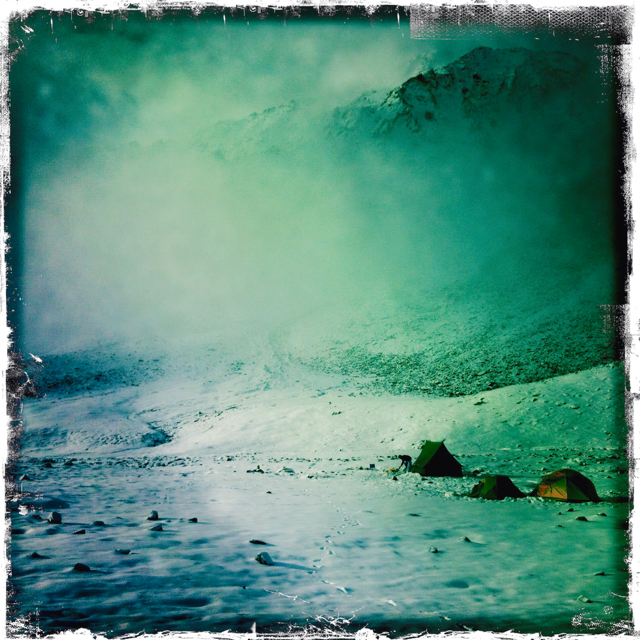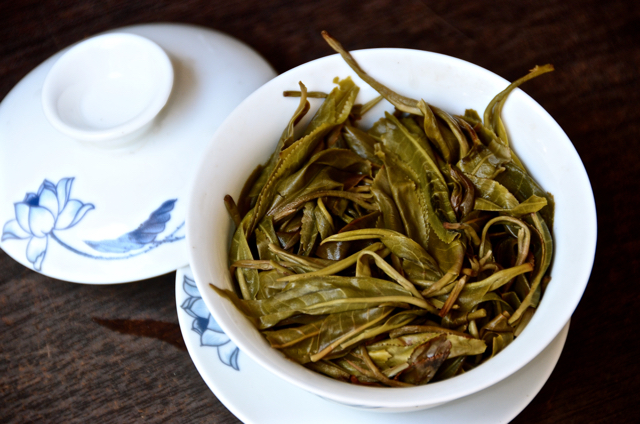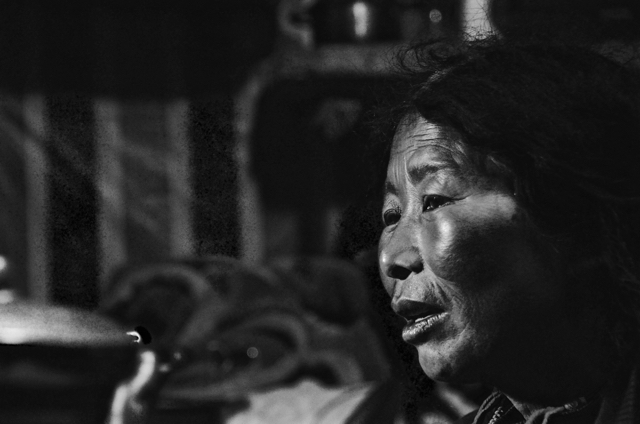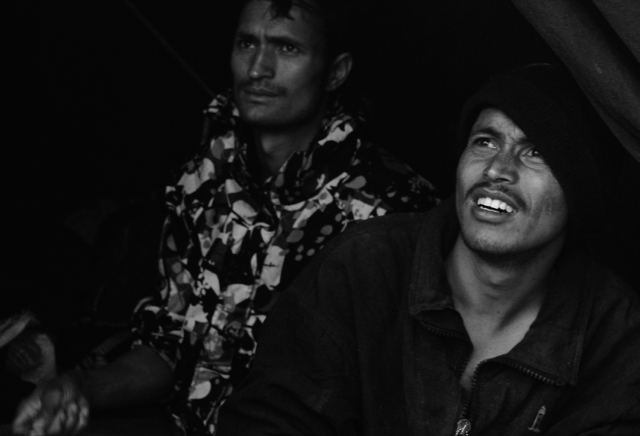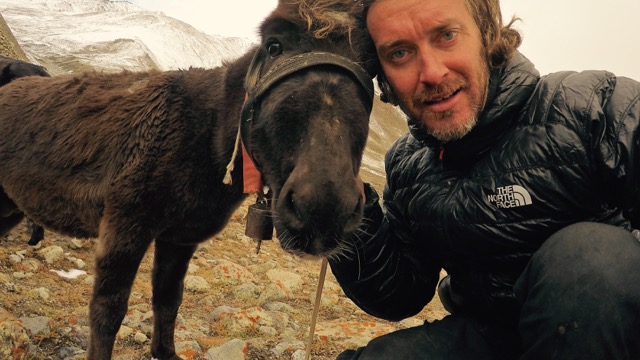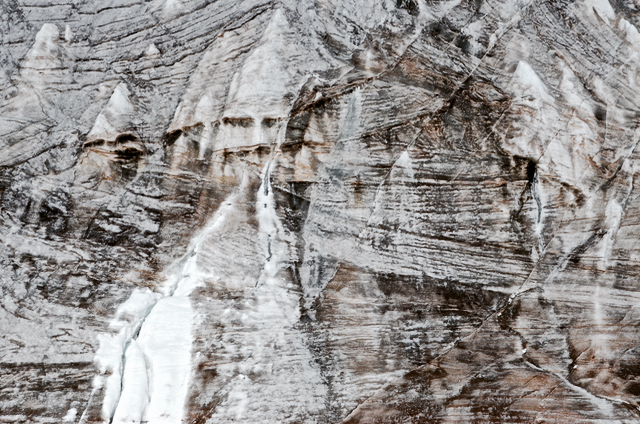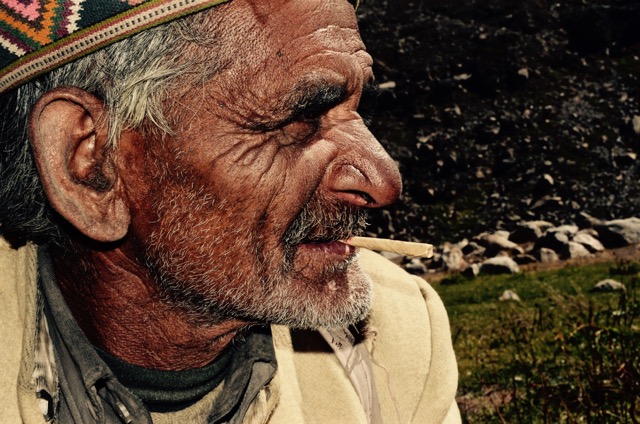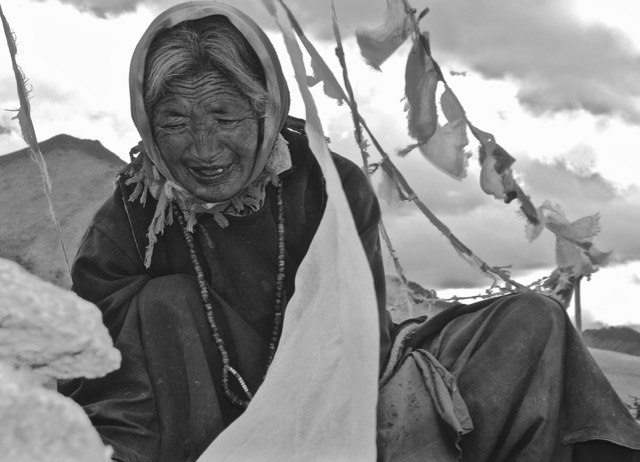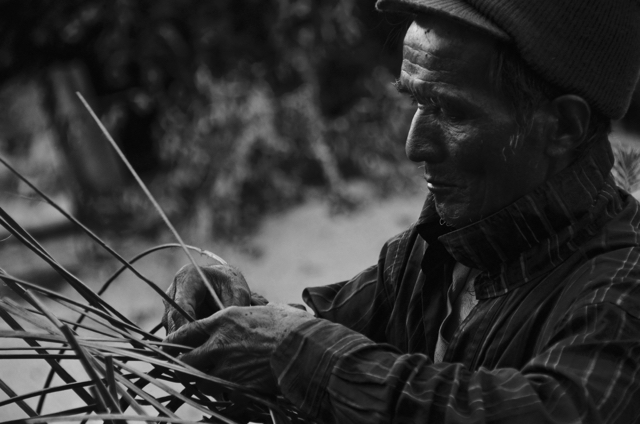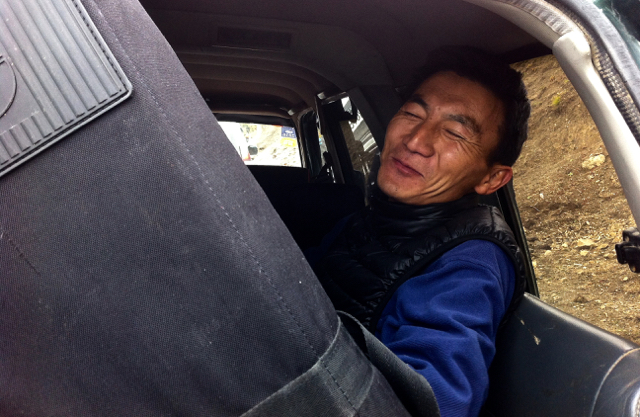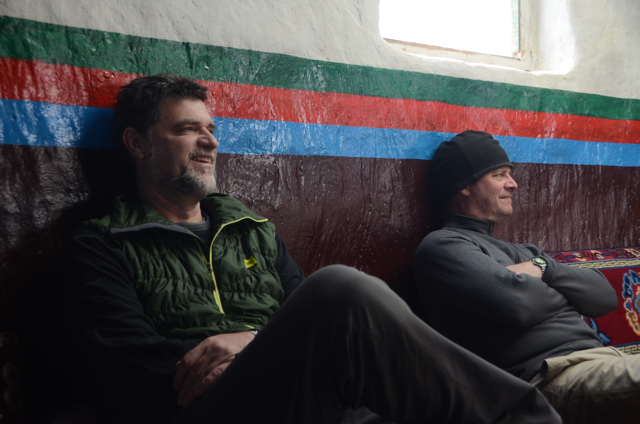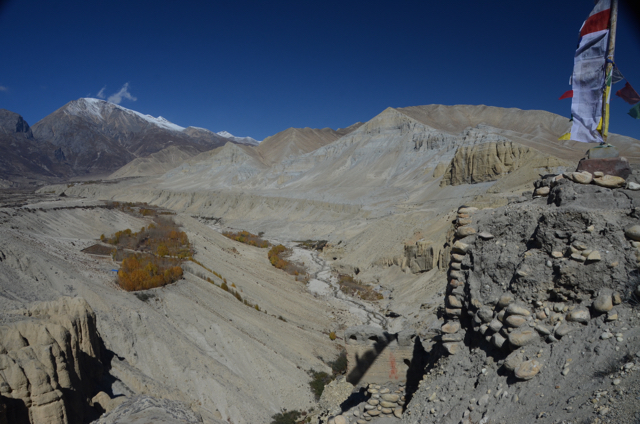The long ridgeline of sediment and stone from a glacier has made a wall beside our trail. Known as an esker it is a thing of power and sculpted magnificence. Accelerating – and then retreating glaciers – have left stone and deposits of sand and grey as some of the only evidence of their wanderings.
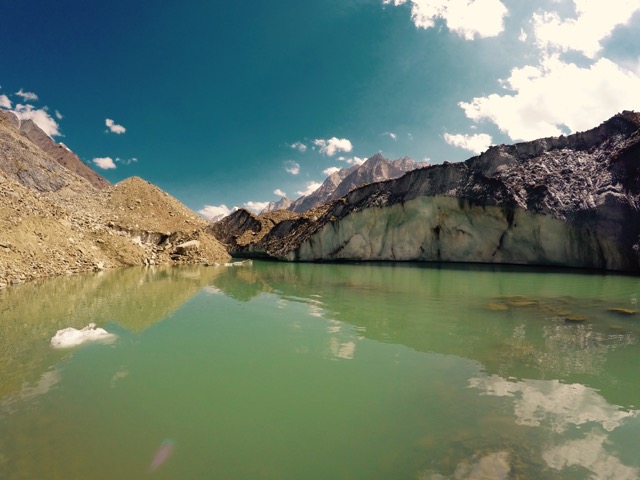
It is such lakes (calm as they might appear) that often develop into danger lakes that have the ability to burst sending a vertical tsunami downwards.
We are leaving Bara Shigri after days of camping upon its multitude of sounds, sheets of ice and sediment tones. Weather has thrown too many hints to remain. Debra remains upbeat and more vitally, with each new pain or discomfort she recovers and it is this recovery that in time tells all of us that she will be fine. Recovery and not necessarily comfort is the vital sign that altitude has not taken too huge a toll.

Meltwater sits in pools beneath ice
I’m a little dull having to leave the vast expanse of crumbling ice and moraine. This glacier is one in perpetual flux, and one in perpetual melt it seems and leaving it in its present form seems somehow a kind of cop out, though there isn’t anything that can physically hold up this world of ice. I wonder what will transpire in the coming seasons. So few come to this valley of moraine. It is only one of many long bodies of ice that need attention.

One of the small sadness’s from our days upon the glacier is the realization that with each ringing “crack”, or crumbling wall and with each rumbling landslide something is lost disappearing for good. Every ice block that falls or cringes into water is forever transformed into water.
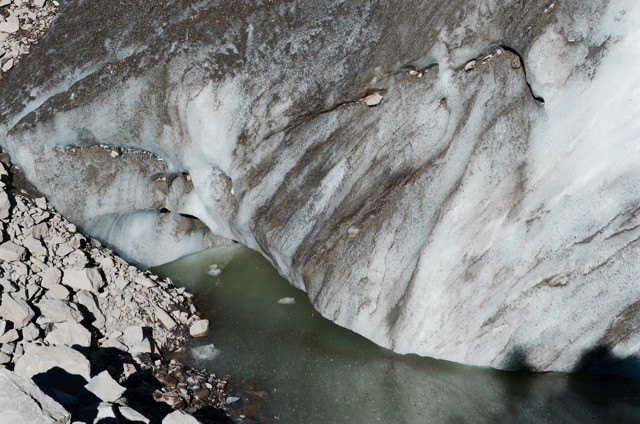
The porters meet our planned descent with approval as the headman Rajesh is worried about what comes from the sky above. He worries as we all do of snow.
We will leave this valley that is so hidden and cold and we’ll head into equally desolate lands where the human element is present.
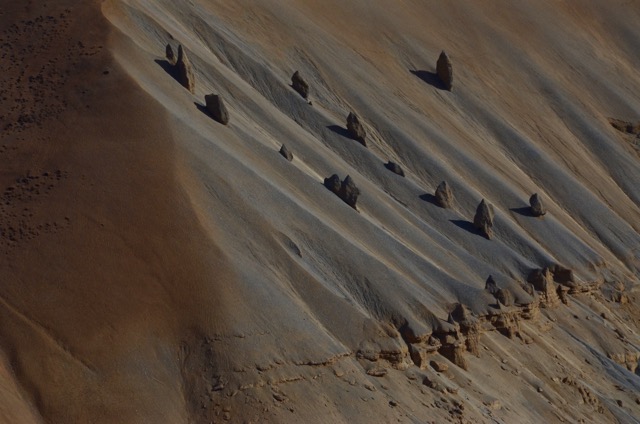
Drying rivers leave silt and sand to be blown high into the mountains creating their own landscapes
Two very long and stagnant descent days later, and having said a brief farewell to our porters we exit off the main road to Leh and go off road in search of a community that is one of three remote valleys. Being jammed into a vehicle after such freedom is strangely not relieving in any form. We are seeking the Karnak people who are one of the small remaining communities that keep to the nomadic way of life. We must now search for their winter dwellings of stone and it is a fixed camp I’ve not been to. Even these intensely rugged people need walls for the intense winter worlds at 4600 metres.
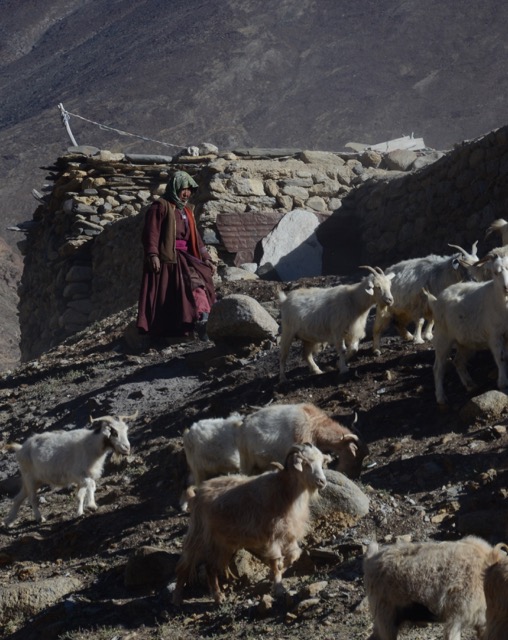
The Karnak’s winter camp
Our first stop to find them leads us to a tucked away valley I’d been to previously. Nothing remains though of them but wind and stone structures. We have missed them and they have moved even deeper into the folds. The Karnak and other nomadic groups are a wonderful counterpoint to what we think of in terms of water usage. They need it yes, but use just a fraction of what most two-legged ones mortals do.
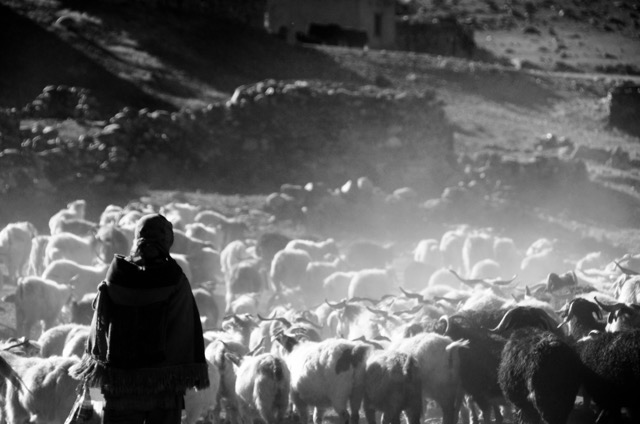
We do eventually find them and their square stone structures. The acrid narcotic fumes of yak and goat dung being burned waft through the winds even with the temperatures below freezing. It is another valley ironically further away from the main road, further away from others.

Welcoming by the locals is not garish but it is warm. We are offered a small plot for our tents and it seems appropriate that we are lodged beside a newly installed pump and a silver stream of glacier water that still putters its way downwards.
Small though this community is, they have a vital commodity which still holds much commercial worth: pashmina. The small pashmina goats along with sheep, yak and errant dogs make up the four-legged population. A small nunnery and its accompanying – and very simple – set of stone huts and meditation caves lie further back in the valley.

An elder pumps water
There is very little to stop winds (and with it the cold) from crushing into the body and it is better to either drink loads of hot tea or simply keep moving. Flecks of hard ice are errantly blowing into every surface of this little community.
Where Bara Shigri is sheer – but isolated – ice-born space, this valley has the human touch (and in this case a welcome human touch). But the cold here is ratcheted up and the wind and air carry a deep current that penetrates fabric, bones, and the psyche alike. The local dogs have a sniff and as always Karma’s presence seems to beckon to them as well. A mangy rust coloured mix has my attention as he is a clever combination of charmer and enforcer. He establishes himself as our local host and will not tolerate any other dogs coming near us. I find out later that Karma had slipped him a treat thereby solidifying his claim to our company.
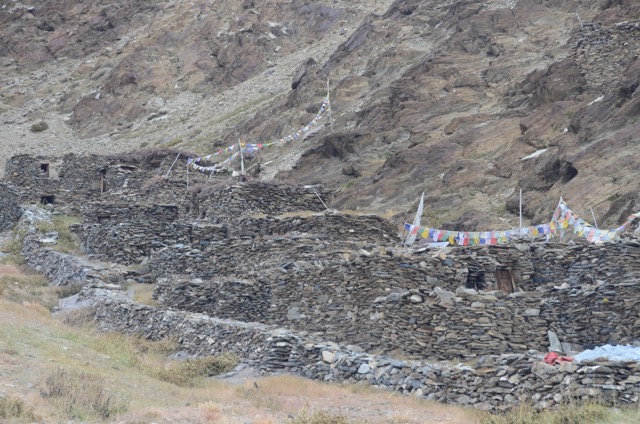
Here water (called “chu”) is everything. It is the base of cooking, of washing, it provides for the animals and its presence is one of the essentials for any camp. Locals do not soil their precious community. There are no faucets here but rather running streams sourced by mountain springs in some cases, and higher mountain glaciers in most. The spring melts enhance the grazing and the cycle continues. Though tucked into a valley we are at 4,600 metres and high above us peaks and ridgelines lie capped in white. Gravity and heat do the rest but even locals mention that they are seeing a change in the snow and ice. Again by “change” it isn’t as though the nomads with more than a thousand years of moving and migrating haven’t become used to every scenario of change. It is the speed in which things are changing and their fear of not being able to adapt to these changes that concerns.
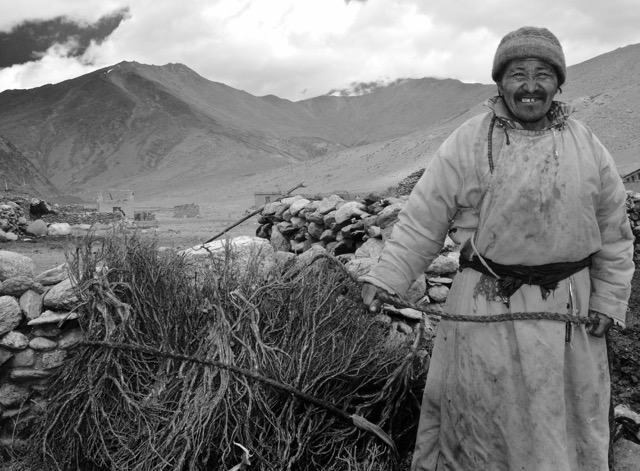
An elder woman comes by often to our tent from the community. Variously she slurps Karma’s teas, offers to sell us Kullu (yak wool) hand loomed carpets, or simply watch what we’re up to. She also comes by to use the pump for water, even though just metres away is the fresh stream water. When I ask why she uses it, the simply nomad logic is immediate, “It is there so I should use it”.
When pumping, it usually takes a few empty pumps of the arm before water comes but it does come. According to her it was put in in the last year though I see in our few days with the Karnak people only this woman using the pump. All of the others move straight to the stream to collect water or wash.
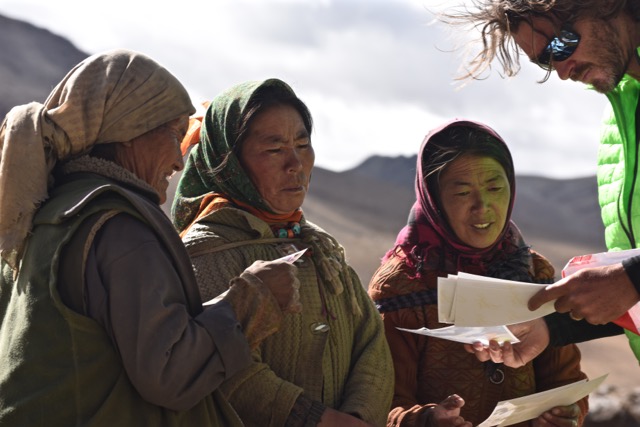
I try to locate nomads using photos I previously took. All but one were found
The local Karnak dress in layers of wool, cotton, with more wool wrapped on top. Heads – and in the afternoon winds – and faces are covered to protect against wind and dust. Hands are seldom covered as they remain vital tools even with the winter’s pending arrival.
When I ask the village headman about remaining in the nomadic fold, he is optimistic and we find out that there are now subsidies from local levels of government that are payed to the nomads. It seems that they will encourage these people of the land to remain if they wish. Our local elder woman who hangs around our camp reminds me later that “We know this land so we should stay”.

Nomadic Yoghurt (called ‘who’) is traditionally served to guests.
It seems so often that the logic is simple with many who don’t have an option to be complicated. The water and the land – the environment – is essential to preserving if the culture is to be preserved. Rugged as they are it is these cultures so close to and dependent upon the land that need gentle hands. They have intuitively taken care of the land. Rotational grazing, care of the waterways, and using their locally sourced wools have made the Karnak and nomadic model of practiced sustainability.
We begin a meal with winds ripping at the tent and finish a meal as all dies down into a deep silence. All things end with a coming together in our mighty kitchen tent.



